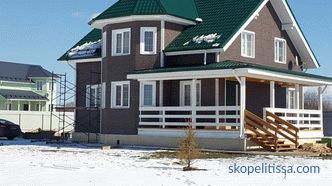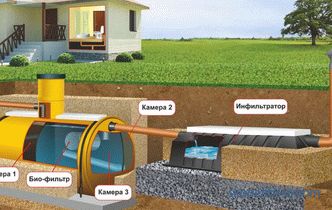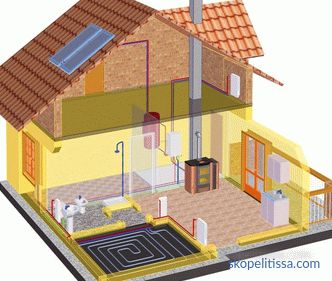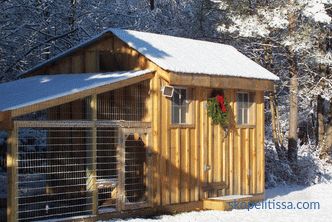If you choose the foundation for the construction of timber or logs, you probably came across information about screw and reinforced concrete (RC) piles. It is especially advantageous to use such supports if the conditions on the site are far from ideal. Today we will consider several offers from real companies and try to figure out by example what technology is better.

Foundation as the basis for a country house
Description of pile types
Let's go for Begin to get acquainted with the definition of each type of pile.
About screw piles
Screw piles are steel hollow pipes with a sharp tip, where the blade is welded. When installed from the inside, they are filled with a cement-sand mixture, which prevents internal corrosion, and the tip is put on top. To protect against the effects of the environment they are coated with a corrosion-resistant coating. As a rule, it is epoxy or galvanized. Relatively recently, manufacturers have appeared on the market that use dual corrosion protection. More on this below.
Installation of screw piles
About reinforced concrete piles
Reinforced concrete piles is a concrete core with a reinforcing cage. For private housing construction, supports with a cross section of 150x150 mm or 200x200 mm are used. When choosing reinforced concrete piles, it is necessary to pay attention to the brand of concrete from which they are cast, and its frost resistance class. From these characteristics depends how strong and durable the foundation will be.
Let us turn to the comparison of technologies. To do this, we take the Standard-1 ”screw piles from the KKZM plant, HelixZINC series helical piles with two-level protection from HelixPRO and RC, zabivny piles from the manufacturer MONTAZhSVAI. RF. What aspects are we interested in? secondly, convenience and possibility of installation for the site, thirdly, the price of components, work and delivery.
Value for money
To begin with, we note that on screw piles, as well as on RC you can build any type of wooden houses (frame-panel, half-timbered, Russky, timbered houses, bathhouses, garages, gazebos, outbuildings, etc. The main thing is to understand the price-quality ratio. If you plan to build a house for permanent or seasonal living and the conditions on the site are good, then it’s only the price. piles have a greater bearing capacity compared to screw ones, but despite this, when designing, they have the same pitch, that is, they cannot save money on quantity.
In continuation of reflections ... If the plans are a bath, a garage or some small house, then it is more profitable to use screw piles. Now the question is: which ones? In appearance, most of them look the same, since there is a black coating on top (if we are not talking about galvanizing). But the coating is different, as they say. Today the price varies from 70 to 700 rubles per liter. You understand that not everything that is black protects the metal from rust. We have not for nothing paid attention to the offer of the plant KKZM. "Standard-1" is a budget version of piles with more or less high-quality protective coating. The manufacturer monitors compliance with the technology, does not use second-hand metal-rolls and buys anticorrosive, which has been tested for years. Such piles will last for more than 80 years with proper installation. Typically, for the construction choose supports with a diameter of 108 mm. To carry out the calculation for a particular house will be able to in the design department.
Speaking of screw piles with double protection against corrosion HelixZINC, we note that these supports have an extended period service. The manufacturer lays 120 years of operation. The meaning of the technology lies in the fact that the piles are covered with hot zinc and from above with an epoxy compound. For what? When installing, the top layer of the coating can be damaged on the stones in the ground. At the place of chips and scratches, corrosion will go to the first It’s a turn that will have a deplorable effect on the foundation as a whole. The barrier layer provides a guarantee against the premature destruction of the metal. Of course, galvanized piles differ in value from conventional ones. But when it comes to building a family nest, the difference will seem insignificant. But for the buildings easier to fit and ordinary piles.
But if it is a question of building a huge wooden house with a large number of rooms, then it is better to give preference to RC for driven piles. One support can withstand a load of 9 to 60 tons depending on the section, while the screw pile has a bearing capacity of up to 10 tons depending on the diameter.
Reinforced concrete piles are a concrete core with a reinforcing cage
Soil
Many depends on the conditions on the site. If the soil is strongly acidic, it is dangerous to install screw piles, as they will quickly rot. Therefore, it is necessary to make a soil test before the start of construction to avoid risk.
There are areas with a large drop in ground level or flooded soil. In this case, on the contrary, it is worthwhile to give preference to screw piles, because during installation they can be increased until the blade reaches a dense soil. In addition, due to the wide base screw pile will be more stable in the soil of this type, where the concrete pile can simply fall into the depths.
Delivery and installation process
Reinforced concrete piles are mounted using a mini piling rig. They are called - precast. The tracked vehicle moves independently around the site, operates at high and low temperatures, and rather quickly mounts supports. But for its delivery to the site requires special equipment. Nevertheless, in one shift, with its help, it is realistic to install about 40 reinforced concrete piles, that is, the foundation for the house.
The mini-pile-driving installation clogs reinforced concrete piles
Screw piles are mounted manually, electromechanically or emergency, with the help of yamobura. The best option is an electromechanical installation. Today it offers any serious company. How does this happen? Screw piles are installed using manual hydraulic machines. That is, the mounting hole is inserted into the gearbox, which creates torque. Compared to the manual method, the electromechanical is advantageously distinguished by depth and mounting speed.
If the section where the foundation is to be installed is difficult to access for one reason or another, manual installation of the screw piles is the only possible way.
Total
Let's summarize the considered aspects of the use of pile-screw and driven reinforced concrete foundations in particular cases:
| Technology / Structure : | Bath / Terrace / Garage | Wooden house (timber / log / frame) | Aerated concrete house (foam block, aerated concrete) | Stone house (brick, monolith) |
| Screw piles | 5 | 5 | 3 | X |
| RC. Pile drive | X * | 3 | 5 | 5 |
* irrational costs
Small buildings and wooden houses of timber or log
Speaking of Gar zakh, baths, terraces, gazebos, fences, cabins and other small and light buildings, we note that the use of concrete piles is not rational. For a conventional log or log house with a residential attic, screw piles are also more often preferred. But if we are talking about a big house, and you are betting on durability, then you can consider the option of RC hammering foundation, because the concrete in the ground practically does not collapse and does not deteriorate.
A house made of lightweight concrete (foam blocks or aerated concrete)
For this type of building, both screw piles and RC are suitable. In the first case, it is worth choosing supports of large diameter and additionally strengthen the foundation. In the second - it is enough to choose the right section. In addition, on reinforced concrete piles paired with a shallow grillage of 600x400 mm, you can safely build even a brick house on three floors.
Brick or monolithic house
Reinforced concrete piles are definitely recommended for a heavy stone structure. Such houses weigh a lot, and the carrying capacity of screw piles will not be enough. Or rather, to provide the necessary bearing capacity, they will have to be screwed in so much that the cost price of the foundation will be comparable to that of a concrete concrete block. In such cases, precast RC slabs should be used.


